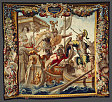View enlargement
Email to a friend
Print this page
After a design by Justus van Egmont (1601–1674)
Woven at the workshop of Willem van Leefdael (1632–1688)
Flanders, Brussels
The Battle of Actium from The Story of Caesar and Cleopatra, c. 1680
Wool and silk, slit and double interlocking tapestry weave
400.6 x 359.5 cm (157 3/4 x 141 1/2 in.)
Gift of Mrs. Chauncey McCormick and Mrs. Richard Ely Danielson, 1944.15
During the winter of 42–41 B.C., Cleopatra became pregnant with twins. The following year, however, Antony returned to Rome and prepared a long-awaited campaign against the Parthians. Yet Octavian failed to support the endeavor. Disappointed, Antony left Italy and sailed to Alexandria, where he renewed his relationship with Cleopatra. Meanwhile, the triumvirate disintegrated, and Octavian rose to power in Rome. Eventually Antony broke off relations with Octavian, and in 31 B.C. civil war broke out again. The decisive sea battle was fought at Actium, a promontory in northern Greece. As depicted in the tapestry, the Egyptian fleet was destroyed by the Romans, and Antony fled to Egypt in Cleopatra’s boat. In 30 B.C., Octavian invaded Egypt. Rather than surrender to his enemy, Antony committed suicide. A few days later, Cleopatra followed his example. Their tragic deaths are not included in this suite.
— Exhibition label, The Divine Art: Four Centuries of European Tapestries, November 1, 2008–January 4, 2009, Regenstein Hall.

